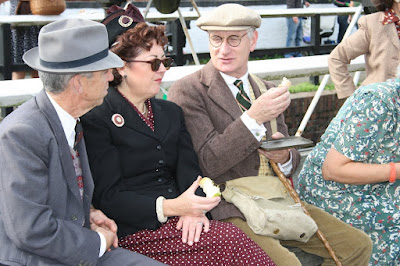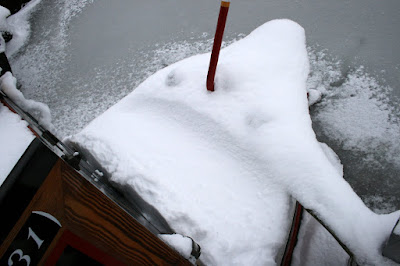We visited the third
Village at War weekend at Stoke Bruerne on Saturday. I don't know how we missed the first two but this weekend's activities made us wish we hadn't. It was quite frankly a remarkable event. The organisers, the
Friends of the Canal Museum, the
Canal Museum and the village, should be very proud.
 Field Marshall Montgomery & colleagues
Field Marshall Montgomery & colleagues
 1940s re-enactors
1940s re-enactors
The weather yesterday was kind, and the crowds came out in force, but today I suspect they may have suffered with the same rain problems as the Ryder Cup in Newport. We had planned to go up to Stoke by boat for the whole weekend but Albert has suffered an electrical problem. The starter motor solenoid appears to have developed a fault and I am certainly not strong enough to start the engine by hand!
 Replica Spitfire Mk IX EN398 on show
Replica Spitfire Mk IX EN398 on show
The first thing that struck us, as we got to Stoke, was the large number of people wandering about in 1940s costume. There were numerous re-enactors playing Land Army girls, the Home Guard, politicians (Winston Churchill), members of the RAF and Army, and civilians of all trades. There must have been well over a hundred people in costume. It was, of course a photographers dream and many cameras with large lenses were in evidence.
 LDV, USA airman and civilians
LDV, USA airman and civilians
(Note the Silver Cross Pram)
 Authentic 1940s picnic
Authentic 1940s picnic
The whole village had adopted the wartime spirit with houses with taped-up windows and bunting, and the primary school acting as a Lyons Corner House. There were displays of military equipment; including jeeps, armoured vehicles, a replica Spitfire with a working Merlin engine, and a wide selection of 1940s cars and vans.
 Vintage Helter Skelter
Vintage Helter Skelter
The boaters, of course, played their part in creating a 1940s atmosphere with crews of working boats in costume. Several of the more familiar working boats attended including Raymond & Nuffield, the tug Pelican, the museum's Sculptor, Cyprus, Victoria, Angel and Corona.
 NB Angel being polished
NB Angel being polished
Amongst the boats was also
Hadar. We have passed Hadar when boating, notably at High House, but have yet to meet fellow bloggers Keith & Jo so it was great to stop and have a good chat with them. They were, of course in costume.
 Jo from NB Hadar in costume
Jo from NB Hadar in costume
 Keith and NB Hadar
Keith and NB Hadar
We were particularly taken with their bargain Measham teapot. Although it is not perfect, it has a few chips, it certainly looks the part.
 Keith & Jo's Measham being admired
Keith & Jo's Measham being admired
There was music in the form of a
George Formby tribute performing in a air raid shelter under the canal bridge.
 Paul Casper aka George Formby performing
Paul Casper aka George Formby performing
There were some really interesting displays in the military display area. We were particularly taken by the authentic Ministry of Food caravan where advice on cooking spam, and cheesecake without cheese, was available. The samples didn't look very palatable!
 Ministry of Food advice caravan
Ministry of Food advice caravan
Just before we left for home we found one of the cottages in Stoke were selling pumpkins; not long to halloween. The purchaser looked very pleased with his purchase.
 Pumpkin and its proud owner
Pumpkin and its proud owner
You will note that I resisted the temptation to reproduce the images in this blog in sepia. I bet lots of images taken at the event will!



















































